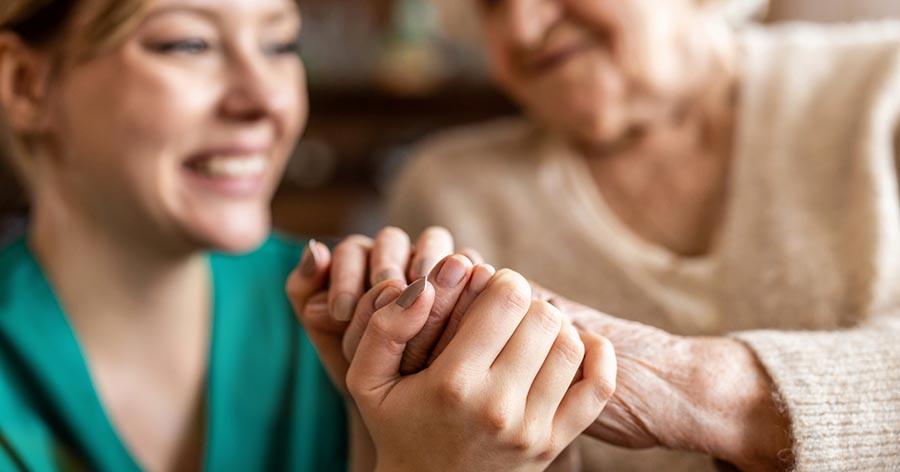The role of community matrons continues to evolve to meet the demands of people living with long-term conditions in the community (NHS England, 2021). Apart from specific roles, such as leadership, finance and budgeting, research, digital technology and providing education and training, their clinical role has led to the introduction of the advanced clinical practitioner competencies. These require advanced clinical assessment skills and V300 non-medical prescribing qualifications (Chater et al, 2019; NHS England, 2021).
Such skills reduce health inequalities in care homes by ensuring that each resident receives the best care outcomes irrespective of their age, sex, culture, race or physical and cognitive abilities. Their role also prevents delays in residents’ treatment (Chater et al, 2019; NHS England, 2021).
This article will review the role of the matron in managing older people living with diabetes in the care home setting, and the value of collaborative working with the diabetes specialist service.
Trends in diabetes care
There are around 490,000 people in the UK residing in 17,600 care homes, with more homes being developed to manage the demand of older people requiring 24-hour care (National Advisory Panel on Care Home Diabetes [NAPCHD], 2022). Of these, 70% are residential homes and 30% are nursing homes. Of the residents, 70% may have a dementia diagnosis or cognitive impairment, while others may have physical disability or other health issues that require a care home stay (NAPCHD, 2022).
Diabetes complications, older age, increased frailty, cognitive/physical disabilities, other comorbidities and living longer can cause increased functional dependence. This makes diabetes management more complex to manage and leads to a more cautious approach in deciding the right treatment for the resident with diabetes in the care home (Sinclair, 2020; NAPCHD, 2022; Wylie et al, 2022; Diabetes UK, 2024b).
This population is heavily reliant on healthcare professionals to treat or prevent hypoglycaemia, manage sick days, meet nutritional and hydration needs, provide daily living activities, and to help them keep active and mobile in care homes (NAPCHD, 2022; Diabetes UK 2024b). If a resident does not have the mental capacity to understand, weigh and make decisions regarding their diabetes, those decisions are made in their best interests (Sinclair, 2020; NAPCHD, 2022; Wylie et al, 2022).
The cost of adult social care in England rose from £14.4 bn in 2010/2011 to £20.5 bn in 2022/2023, an increase from 12% to 16% of total net expenditure (Figure 1). It is the biggest local authority expenditure after education and is expected to rise (Foster, 2024).
Of an estimated 5.6 million people with diabetes in the UK, 4.5 million have a diagnosis, while over a third are over the age of 65 years. A further increase of 0.8 million is predicted in the overall population by 2025, including a greater proportion of older people (Diabetes UK, 2024a; Diabetes UK 2024b; Wylie et al, 2022).
A pragmatic review found that the direct cost of diabetes in the UK in 2021/22 was around £10.7 bn, with 60% of this being associated with the excess costs of complications, and 40% related to treatment and diagnosis. Indirect costs, such as unemployment, informal care giving and time off from work due to sickness or care giving was around £3.3 bn. It estimated that annual NHS spend for diabetes, including for those in care homes, could reach £18 bn by 2035 (Hex et al, 2024).
An economic evaluation study found that hospital care costs incurred for people for diabetes was around £5.5 bn per year (Stedman et al, 2020). Another report found that a £3 bn cost could be avoided if diabetes was managed effectively in the community (Robinson, 2019).
Increased healthcare expenditure for people living with diabetes in care homes is related to hospitalisation owing to acute illness or hypoglycaemia, increased medication, extra staff and the transfer of ill residents to nursing beds in the same care home, additional GP and community call-outs, and non-staffing costs (such as for clinical supplies).
Outcomes for a person living diabetes in a care home to reduce health care expenditure should, therefore, focus on:
- Reduced avoidable hospital admissions.
- Improved quality of life/family involvement.
- An advance care plan that reflects how the person with diabetes wishes to be cared for in the care home, and as they approach end of life.
- Healthy nutrition.
- Encouragement of independence, as able.
- Adequate physical, physiological and mental health support across all Rockwood frailty scores.
- A diabetes care plan specifying glycaemic, blood pressure and cholesterol targets.
- A simplified treatment in diabetes care.
- Reduced diabetes emergencies.
- Confident and competent nurses and carers to deliver diabetes care.
- Provision to attend retinal and feet screening (Sinclair, 2020).
Whilst these points form part of the community diabetes specialist nurse (DSN) assessment, the increasing population with diabetes, and the daily demands of the diabetes service, will require more nurses and carers to be competent in managing the complexities of diabetes in care homes (Sinclair, 2020; NAPCHD, 2022).

The role of the community matron
Utilising advance practitioners, such as community matrons, becomes relevant because they work collaboratively with DSNs to support nurses and carers with relevant competencies to improve outcomes for people living with diabetes in the care home (Chater et al, 2019). Their main aim is to provide care in the community, away from the hospital environment, and improve health outcomes for care home residents.
Since the Covid-19 epidemic, secondary, community and primary care have been proactive in managing diabetes in care homes (Sinclair, 2020; NAPCHD, 2022). The community matron has played a major role in reducing delays in treatment and preventing hospital admissions for residents living with diabetes in care homes (Ali et al, 2021).
An evaluation programme found that the presence of a matron supporting a care home resulted in a 15% reduction in emergency calls and a 19% reduction in hospital admissions over a four-year period (Giebel et al, 2020). The number of hospital admissions increased when the study ended.
The community matron role is highly autonomous and skilled. It requires at least 3 years of nursing practice, either in inpatient care or the community to improve confidence in autonomous nursing practice. Nurses aspiring to enter that role must have a nursing degree and be registered with the Nursing and Midwifery Council (NMC) in the UK. A community matron must hold a post-graduate qualification in advance clinical practice, such as the advanced clinical assessment and the V300 non-medical prescribing qualifications at level 6 or 7, or be working towards a full master’s in advance clinical practice (Chater et al, 2019; NHS England 2021).
Their prescribing role enables medication reviews, dose adjustment and prescribing new medication to prevent delays in treatment and reduce avoidable hospital admissions (Chater et al, 2019). They are also expected to keep up to date with best practices and advances in healthcare to ensure patient safety. They may be required, therefore, to undertake specialist courses, such as on chronic disease management, leadership and practice teaching, to improve their advance clinical practice skills (Chater et al, 2019; NHS England 2021).
Mentoring or practice teaching qualifications provide additional benefits for developing training sessions in the care homes to support nurses’ and carers’ competencies (Bentley, 2014; NHS England, 2021).
The role of a community matron supporting a care home includes undertaking urgent reviews in care homes and post-discharge reviews following a hospital admission (Giebel et al, 2020). They carry out new resident assessments for inpatients with increased care and nursing needs requiring care home placements, and facilitate early hospital discharges. Hospitals are not always the best environments for older people, especially if they have existing comorbidities and increased frailty, as they are at increased risk of hospital-acquired infections (Giebel et al, 2020; Bentley, 2014).
They work very closely with residents, the allocated GP, multidisciplinary team in the nursing home, healthcare professionals in the community, secondary care and families to ensure the best outcomes (Giebel et al, 2020; Bentley, 2014). Each community matron manages an assigned group of care homes.
The community matron is an advocate for residents in care homes and their families, undertaking complex discussions with families and keeping them involved in the diabetes care. A crucial part or their role is developing advanced care plans as a person approaches the end of their life, to ensure their wishes are respected (Bentley, 2014).
When diabetes care becomes complex and requires a review, the community matron and care home need to refer to the GP or community DSN for a specialist review. Therefore, understanding the criteria for referral to each is crucial. For example, a person with diabetes in a care home who is not on the maximum dose of three oral therapies without tolerance issues or unexplained hypoglycaemia would be managed with the GPs in primary care (Ali et al, 2021).
Complex diabetes care on maximum doses of oral diabetes medication, requiring injectables or already on injectables, education on type 2 diabetes following diagnosis, advanced chronic kidney disease, tolerance issues with oral medication, type 1 diabetes or unexplained hypoglycaemia in the care homes need to be referred to the community diabetes service (Ali et al, 2021).
From anecdotal experience, when a care home resident is referred to the community diabetes service, the expectation is that the community DSN carries out an initial assessment, and develops and agrees a care plan with the community matron, patient and their next of kin or person with lasting power of attorney. The DSNs will review the patient’s progress over 4 weeks and discharge back to the community matron with a detailed care plan.
This allows manageable caseloads for the DSNs and the community matron, and enables care to sit in the right place. The community matrons can always refer to the DSNs if there are further concerns. However, it is crucial that seamless communication exists between the diabetes service, care home and community matron to prevent delays to reviews or treatment, or a re-referral. Both services should have telephone contacts and email addresses for communication.
The beauty of the community matrons and the community diabetes team working collaboratively is that the diabetes nurse carries out the assessment, establishes the clinical impression, sets a target and puts a safe treatment plan in place that is tailored to the resident with diabetes in the care home. The community matron uses the advanced clinical assessment and prescribing role to review and titrate doses based on the care plan and the target set for patients. By working together, the services reduce anxiety among care home staff in managing complex diabetes, as they have a clear guide to follow and contact details if there are concerns (Bentley, 2014; Sinclair, 2020; Wylie et al, 2022).
It is always useful if a DSN is assigned to a locality or primary care network to support care homes, as primary and secondary care, the community matron and district nurses will have a point of contact if they are worried about a resident. This collaborative working helps to upskill the community diabetes nurse, with their advance clinical assessment, and the matron, with their diabetes management competencies.
A borough in north London has a community matron team that is proactively working with the community diabetes service to improve outcomes of resident living with diabetes in care homes, and this works very well.
Conclusion
The care of a person with diabetes in a care home is complex, owing to existing comorbidities and increased frailty. For people living with diabetes in care homes, the community matron is valuable in tackling health inequalities, preventing delays in diabetes treatment, ensuring high quality of care and reducing hospital admissions.
Collaborative working must exist between the community diabetes team and the community matron service to achieve this. Areas that do not have this type of support may want to consider implementing such a useful service.






NHS type 2 diabetes prevention initiative reaches more people than ever.
5 Jun 2025